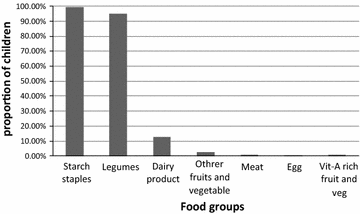Vitamin-A deficiency and its determinants among preschool children: a community based cross-sectional study in Ethiopia
- PMID: 27342570
- PMCID: PMC4920990
- DOI: 10.1186/s13104-016-2134-z
Vitamin-A deficiency and its determinants among preschool children: a community based cross-sectional study in Ethiopia
Abstract
Background: Vitamin A deficiency is the leading cause of preventable visual impairments in children. It is also an underlying cause for nearly one-fourth of global child mortality associated with measles, diarrhea, and malaria. The limited literature available in Ethiopia shows severe public health significance of vitamin-A deficiency. Hence the aim of the current study was to assess the prevalence and factors determining vitamin-A deficiency among preschool children in Dembia District, northwest Ethiopia.
Methods: A community-based cross-sectional study was conducted among preschool children of Dembia District from January to February, 2015. A multi-stage sampling, followed by a systematic sampling technique was employed to select study participants. A structured interviewer-administered questionnaire was used to collect data. Using a binary logistic regression model, multivariable analysis was fitted to identify the associated factors of vitamin-A deficiency. The adjusted odds ratio (AOR) with a 95 % confidence interval was computed to assess the strength of the association, and variables with a p value of <0.05 in multivariable analysis were considered as statistically significant.
Results: Six hundred eighty-one preschool children were included in the study, giving a response rate of 96.5 %. The overall prevalence of xerophthalmia was 8.6 %. The result of the multivariable analysis revealed that nonattendance at the antenatal care clinic [AOR 2.65,95 % CI (1.39,5.07)], being male [AOR 1.81, 95 % CI (1.01,3.24)], and in the age group of 49-59 months [AOR 3.00, 95 % CI (1.49,6.02)] were significantly associated with vitamin-A deficiency.
Conclusions: Vitamin-A deficiency is a severe public health problem in the study area. Further strengthening antenatal care utilization and giving emphasis to preschool children will help to mitigate vitamin-A deficiency in the study area.
Keywords: Determinants; Ethiopia; Preschool children; Xerophthalmia.
Figures
References
-
- WHO. Global prevalence of vitamin A deficiency in populations at risk 1995–2005. WHO global database on vitamin A deficiency. Geneva: World Health Organization; 2009.
-
- Arimond M, Ruel MT. Progress in developing an infant and child feeding index: an example using the Ethiopia demographic and health survey 2000. International Food Policy Research Institute Washington, DC; 2002.
-
- West KP. Extent of vitamin A deficiency among preschool children and women of reproductive. J Nutr. 2002;132:2857S–2866S. - PubMed
-
- Rice A, West K, Black R, Ezzati M, Lopez A, Rodgers A, Murray C. Comparative quantification of health risks: global and regional burden of disease attributable to selected major risk factors, vol. 1. Geneva: World Health Organization; 2004.
MeSH terms
LinkOut - more resources
Full Text Sources
Other Literature Sources



